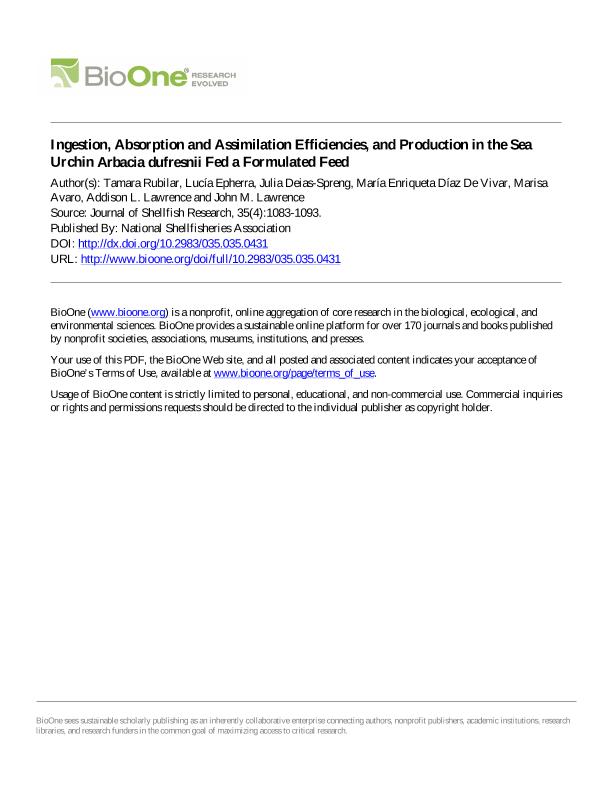Mostrar el registro sencillo del ítem
dc.contributor.author
Rubilar Panasiuk, Cynthia Tamara

dc.contributor.author
Epherra, Lucía

dc.contributor.author
Deias Spreng, Julia
dc.contributor.author
Díaz de Vivar, María Enriqueta Adela

dc.contributor.author
Avaro, Marisa Gladis

dc.contributor.author
Lawrence, Addison L.
dc.contributor.author
Lawrence, John M.
dc.date.available
2018-02-21T21:11:33Z
dc.date.issued
2016-12
dc.identifier.citation
Rubilar Panasiuk, Cynthia Tamara; Epherra, Lucía; Deias Spreng, Julia; Díaz de Vivar, María Enriqueta Adela; Avaro, Marisa Gladis; et al.; Ingestion, Absorption and Assimilation Efficiencies, and Production in the Sea Urchin Arbacia dufresnii Fed a Formulated Feed; National Shellfisheries Association; Journal Of Shellfish Research; 35; 4; 12-2016; 1083-1093
dc.identifier.issn
0730-8000
dc.identifier.uri
http://hdl.handle.net/11336/36937
dc.description.abstract
Sea urchins have been used as a source of food from prehistoric times and as a research animal model since the 19th century. They presently are harvested in many parts of the world. In Argentina, sea urchins have been studied only from biological perspectives. Of the 14 species of sea urchins found off the coast of Argentina, Arbacia dufresnii is the most abundant. It is an omnivorous species that exists in dense populations in Nuevo Gulf. Biomass production in sea urchins, especially gonad yield, is related to food quantity and quality. In the field, A. dufresnii has a small size and low gonad biomass and gamete production. Therefore to test the hypothesis that a high-quality formulated food would produce more biomass and gonad yield than that found in the sea urchins from a natural population, sea urchins were reared in a laboratory aquaculture system for 8 wk in autumn when gametogenesis occurs. In April, 30 sea urchins were collected and dissected to establish the initial condition (Baseline). Another 32 sea urchins were collected in April and maintained until June in aquaria at constant temperature and salinity and fed a formulated feed (Fed). At the conclusion of the experiment, 30 sea urchins were collected from the field population in June (Field) to establish the population condition in the Field and for comparison with the Fed sea urchins. Fed sea urchins had a 20% greater gain in weight resulting from an increase in both somatic and gonadal tissue beyond that of the field population. All organs increased in weight in females and all organs except the lantern in males. The absorption efficiency in Fed sea urchins was over 80%. Fed sea urchin had organic biomass production higher than Field sea urchins. Differences were found in the gonad cellular composition: Fed females had a unimodal oocyte size-frequency distribution, in contrast to a multimodal distribution in Field females. Fed males had fewer mature gametes than Field males. Both testes and ovaries had more nutritive phagocytes in Fed sea urchins than in Field sea urchins. Proximate composition of gonads, however, was similar in Fed and Field sea urchins. Fed individuals showed a remarkable increase in biomass production. The biochemical and cellular composition of the gonads reflected this. This indicates that A. dufresnii fed a highly nutritional food is able to assimilate nutrients with high efficiency and produce an increased gonad yield.
dc.format
application/pdf
dc.language.iso
eng
dc.publisher
National Shellfisheries Association

dc.rights
info:eu-repo/semantics/openAccess
dc.rights.uri
https://creativecommons.org/licenses/by-nc-sa/2.5/ar/
dc.subject
Arbacia Dufresnii
dc.subject
Artificial Fed
dc.subject
Echinoidea
dc.subject
Production
dc.subject.classification
Otras Ciencias Biológicas

dc.subject.classification
Ciencias Biológicas

dc.subject.classification
CIENCIAS NATURALES Y EXACTAS

dc.title
Ingestion, Absorption and Assimilation Efficiencies, and Production in the Sea Urchin Arbacia dufresnii Fed a Formulated Feed
dc.type
info:eu-repo/semantics/article
dc.type
info:ar-repo/semantics/artículo
dc.type
info:eu-repo/semantics/publishedVersion
dc.date.updated
2018-02-19T13:15:28Z
dc.journal.volume
35
dc.journal.number
4
dc.journal.pagination
1083-1093
dc.journal.pais
Estados Unidos

dc.description.fil
Fil: Rubilar Panasiuk, Cynthia Tamara. Consejo Nacional de Investigaciones Científicas y Técnicas. Centro Científico Tecnológico Conicet - Centro Nacional Patagónico. Centro para el Estudio de Sistemas Marinos; Argentina
dc.description.fil
Fil: Epherra, Lucía. Consejo Nacional de Investigaciones Científicas y Técnicas. Centro Científico Tecnológico Conicet - Centro Nacional Patagónico. Instituto de Diversidad y Evolución Austral; Argentina
dc.description.fil
Fil: Deias Spreng, Julia. Universidad Nacional de la Patagonia; Argentina
dc.description.fil
Fil: Díaz de Vivar, María Enriqueta Adela. Universidad Nacional de la Patagonia; Argentina
dc.description.fil
Fil: Avaro, Marisa Gladis. Universidad Nacional de la Patagonia; Argentina
dc.description.fil
Fil: Lawrence, Addison L.. Texas A&M University System; Estados Unidos
dc.description.fil
Fil: Lawrence, John M.. University of South Florida; Estados Unidos
dc.journal.title
Journal Of Shellfish Research

dc.relation.alternativeid
info:eu-repo/semantics/altIdentifier/doi/http://dx.doi.org/10.2983/035.035.0431
dc.relation.alternativeid
info:eu-repo/semantics/altIdentifier/url/http://www.bioone.org/doi/full/10.2983/035.035.0431
Archivos asociados
